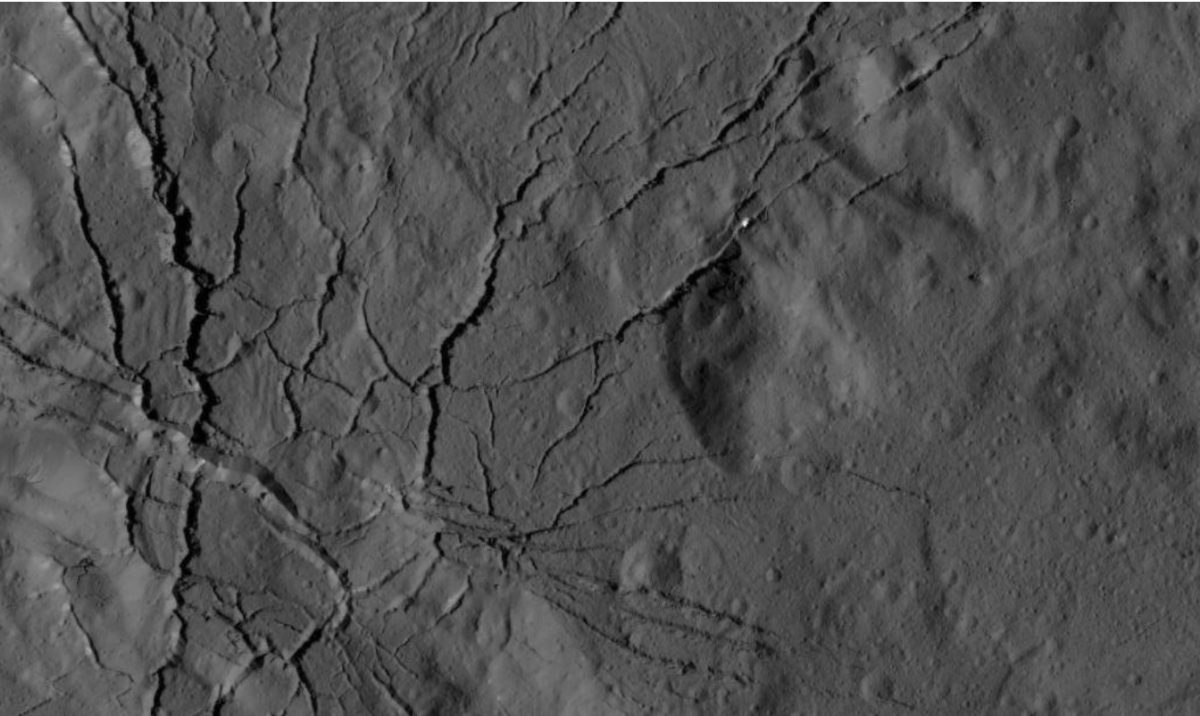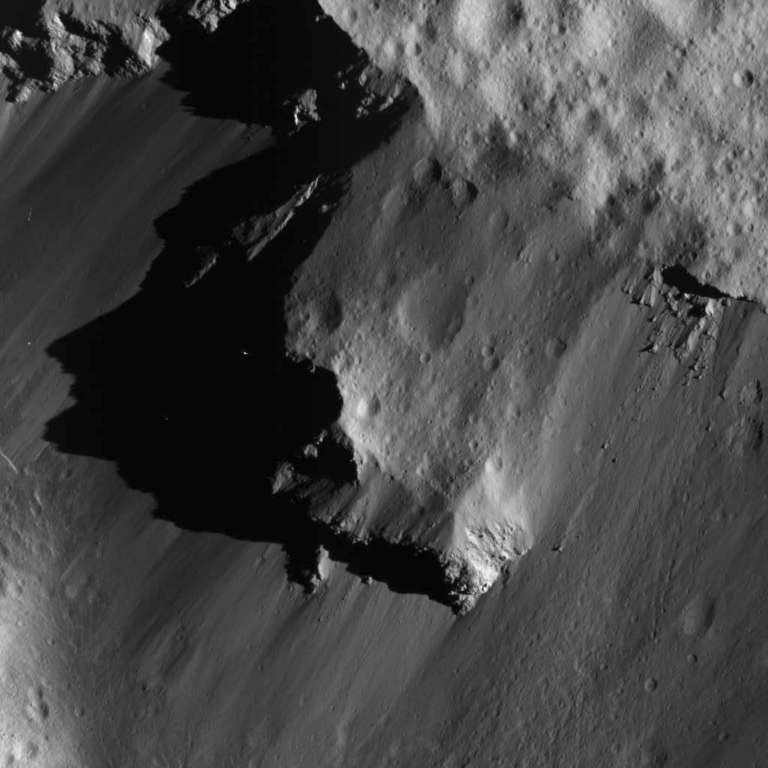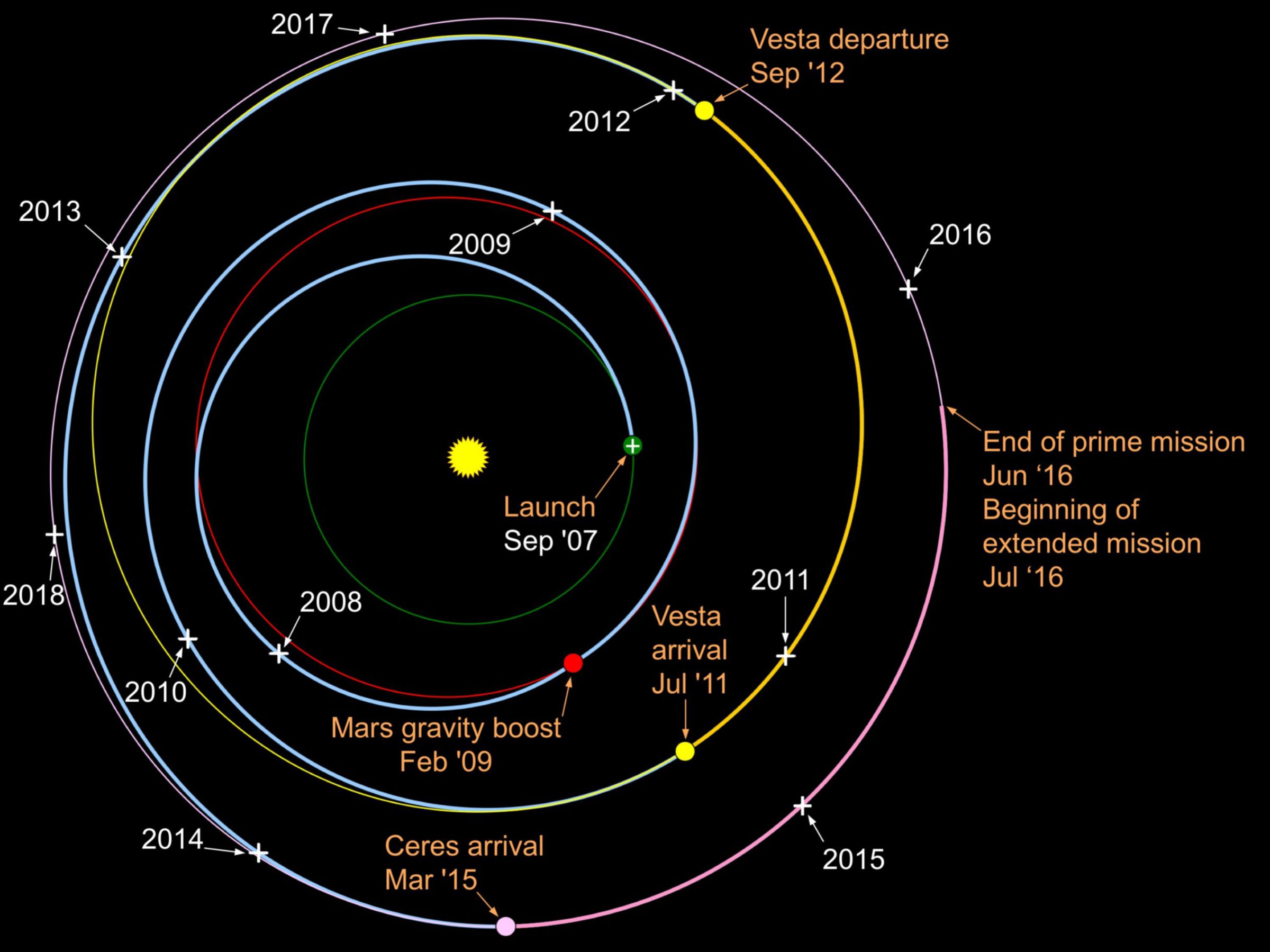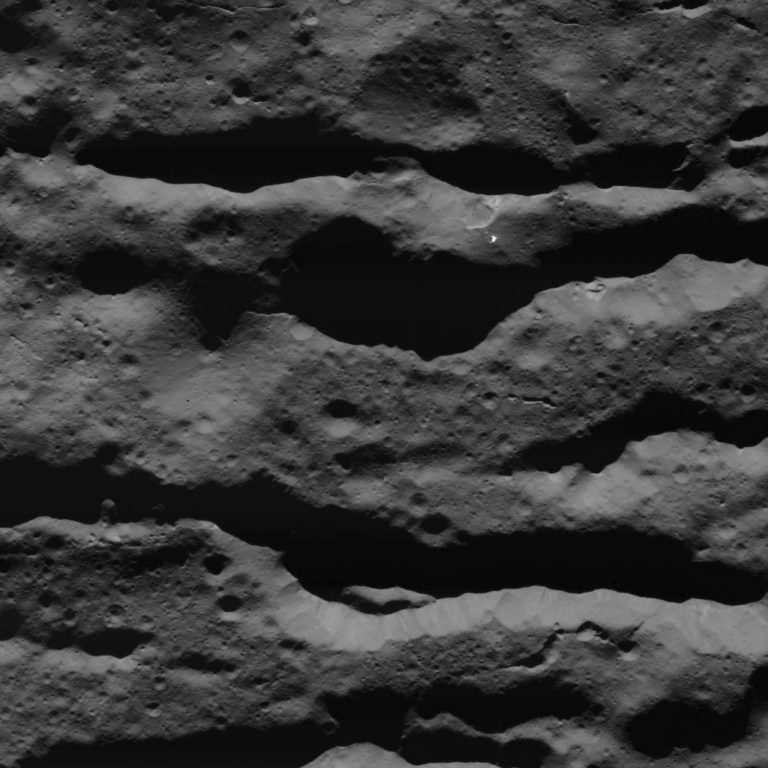Marc Rayman • Oct 19, 2018
Dawn Journal: 11 Years in Space
Dear Dawnniversaries,
Today Dawn is celebrating its 11th anniversary of spaceflight. This is the last dawnniversary the spacecraft will see. The venerable adventurer's mission will end very soon. Indeed, it could happen at any moment. In the meantime, Dawn is making the most of its remaining lifetime, performing exquisitely detailed measurements of dwarf planet Ceres. It will do so right to the very last moment.

In the two Dawn Journals from last month, we described the end of the mission (and what will happen for the next few decades). But with the probe still operating, let's join it in reviewing how far it has come since leaving Cape Canaveral 11 years ago.

After its short dawn ride to space on a Delta, Dawn began its long interplanetary expedition atop a cool blue beam from its ion engines. The spacecraft sailed past Mars in 2009 and in 2011 entered orbit around Vesta, the second largest body in the main asteroid belt. During 14 months there, it revealed Vesta to be more like the terrestrial planets, including the one on which Dawn was conceived and built (and where its controllers still reside), than like the much smaller chunks of rock we know as asteroids. In 2012, propelled by a zephyr of xenon ions, the ship set sail on the cosmic seas once again, its sights set on the largest uncharted world between the Sun and Pluto. Ceres took the traveler into a gentle but permanent gravitational hold in 2015. Thanks to curious and creative creatures on Earth, Ceres now has a moon named Dawn.
During its 11th year in deep space, the explorer undertook some of its most ambitious activities of the entire mission. Unlike missions limited to a brief glimpse of their targets during a flyby, Dawn has taken great advantage of being able to conduct comprehensive studies of Ceres (and Vesta). And thanks to the maneuverability afforded by its ion engines, the spacecraft has frequently changed its orbit to optimize its investigations. We described earlier this year how Dawn flew to extended mission orbit 6 (XMO6) for a new campaign of photography and other measurements. Following that, early in June the spaceship used its ion engine to descend to XMO7, in which it dives down to about 22 miles (35 kilometers) above the ground, only three times your altitude when you travel in a commercial jet. (Perhaps you ought to consider traveling by spaceship. Note that Dawn travels a little faster than a jet, although it does require some patience to reach the top speed. We will see more about this below.)

The orbit was initially aligned so the low point, known as peridemeter, would be in the vicinity of Occator Crater on the dayside of Ceres, allowing the spacecraft to obtain stunning pictures and other data. We discussed in March and in June that the peridemeter gradually shifts south. As it did so, the focus of the close-up observations moved to Urvara Crater. In late August, to the delight of everyone interested in the exploration of space, Dawn was still operating productively, and by then, the peridemeter had moved to its greatest southerly latitude of 84° (corresponding to the orbital inclination, for those who understand orbits). Since then, it has progressed north on the other side of Ceres, opposite the Sun. (If this progression isn't clear, see the diagram in March and imagine continuing the trend of the orbital precession it illustrates.) Now the peridemeter has moved so far to the nightside that throughout Dawn's time over illuminated terrain, it is higher than it was in previous orbits. There is little new to see now from higher up. Therefore, Dawn no longer conducts visible or infrared observations, but it is continuing to measure nuclear radiation and the gravity field, both of which provide valuable insight into the nature of the dwarf planet.
On every Sept. 27, we reflect on this unique interplanetary adventure. For those who would like to track the probe’s progress in the same terms used on past anniversaries, we present here the 11th annual summary, reusing text from previous years with updates where appropriate. Readers who wish to investigate Dawn’s ambitious journey in detail may find it helpful to compare this material with the Dawn Journals from its first, second, third, fourth, fifth, sixth, seventh, eighth, ninth and tenth anniversaries.
In its 11 years of interplanetary travels, the spacecraft has thrust with its ion engines for a total of 2,141 days (5.9 years), or 53 percent of the time (and 0.000000043 percent of the time since the Big Bang). While for most spacecraft, firing a thruster to change course is a special event, it is Dawn’s wont. All this thrusting has cost the craft only 907 pounds (411 kilograms) of its supply of xenon propellant, which was 937 pounds (425 kilograms) on Sept. 27, 2007. The spacecraft has used 69 of the 71 gallons (261 of the 270 liters) of xenon it carried when it rode its rocket from Earth into space. (Note that on the tenth anniversary, we actually gave a slightly higher xenon cost. Dawn has not refueled since then. For technical reasons we will not delve into, it is very difficult to compute the xenon consumption late in the mission. Engineers devoted extensive effort to refining their measurements of the xenon during the past year, resulting in a small change in their final calculation of how much xenon Dawn has used.) We saw in June that Dawn will never use its ion propulsion system again. We have the spacecraft right where we want it.

The thrusting since launch has achieved the equivalent of accelerating the probe by 25,700 mph (41,400 kph). As previous logs have described (see here for one of the more extensive discussions), because of the principles of motion for orbital flight, whether around the Sun or any other gravitating body, Dawn is not actually traveling this much faster than when it launched. But the effective change in speed remains a useful measure of the effect of any spacecraft’s propulsive work. Dawn has far exceeded the velocity change achieved by any other spacecraft under its own power. (For a comparison with probes that enter orbit around Mars, refer to this earlier log.) It is remarkable that Dawn’s ion propulsion system has provided nearly the same change in speed as the entire Delta rocket.
Since launch, our readers who have remained on or near Earth have completed 11 revolutions around the Sun, covering 69.1 AU (6.4 billion miles, or 10.3 billion kilometers). Orbiting farther from the Sun, and thus moving at a more leisurely pace, Dawn has traveled 46.4 AU (4.3 billion miles, or 6.9 billion kilometers). As it climbed away from the Sun, up the solar system hill to match its orbit to that of Vesta, it continued to slow down to Vesta’s speed. It had to go even slower to perform its graceful rendezvous with Ceres. In the 11 years since Dawn began its voyage, Vesta has traveled only 44.9 AU (4.2 billion miles, or 6.7 billion kilometers), and the even more sedate Ceres has gone 41.8 AU (3.9 billion miles, or 6.3 billion kilometers). (To develop a feeling for the relative speeds, you might reread this paragraph while paying attention to only one set of units, whether you choose AU, miles or kilometers. Ignore the other two scales so you can focus on the differences in distance among Earth, Dawn, Vesta and Ceres over the 11 years. You will see that as the strength of the Sun’s gravitational grip weakens at greater distance, the corresponding orbital speed decreases.)
Comparing mileage with cars is highly misleading, but some readers can't help but try to make that comparison. The reason it is deceptive is that cars have to keep burning fuel to move as they overcome friction, but orbiting objects normally move without propulsion at all. Earth has completed its annual trip around the Sun (currently 584 million miles, or 940 million kilometers) for billions of years without requiring any propellant at all. Similarly, spacecraft coast most of the time. With ion propulsion, Dawn (and Deep Space 1 before it) were the exceptions, thrusting more often than coasting. But readers who require a comparison with their car (or their spaceship) can credit Dawn with 63 million miles per gallon (0.0000038 liters per 100 kilometers, or 3.8 liters per 100 million kilometers).
Another way to investigate the progress of the mission is to chart how Dawn’s orbit around the Sun has changed. This discussion will culminate with even more numbers than we usually include, and readers who prefer not to indulge may skip this material, leaving that much more for the grateful Numerivores. (If you prefer not to skip it, click here.) In order to make the table below comprehensible (and to fulfill our commitment of environmental responsibility), we recycle some more text here on the nature of orbits.
Orbits are ellipses (like flattened circles, or ovals in which the ends are of equal size). So as members of the solar system family (including Earth, Dawn, Vesta and Ceres) follow their individual paths around the Sun, they sometimes move closer and sometimes move farther from it.

In addition to orbits being characterized by shape, or equivalently by the amount of flattening (that is, the deviation from being a perfect circle), and by size, they may be described in part by how they are oriented in space. Using the bias of terrestrial astronomers, the plane of Earth’s orbit around the Sun (known as the ecliptic) is a good reference. Other planets and interplanetary spacecraft may travel in orbits that are tipped at some angle to that. The angle between the ecliptic and the plane of another body’s orbit around the Sun is the inclination of that orbit. Vesta and Ceres do not orbit the Sun in the same plane that Earth does, and Dawn must match its orbit to that of its targets. (The major planets orbit closer to the ecliptic, and part of the arduousness of Dawn’s journey has been changing the inclination of its orbit, an energetically expensive task.)
Now we can see how Dawn has done by considering the size and shape (together expressed by the minimum and maximum distances from the Sun) and inclination of its orbit on each of its anniversaries. (Experts readily recognize that there is more to describing an orbit than these parameters. Our policy remains that we link to the experts’ websites when their readership extends to one more elliptical galaxy than ours does.)
The table below shows what the orbit would have been if the spacecraft had terminated ion thrusting on its anniversaries; the orbits of its destinations, Vesta and Ceres, are included for comparison. Of course, when Dawn was on the launch pad on Sept. 27, 2007, its orbit around the Sun was exactly Earth’s orbit. After launch, it was in its own solar orbit.
| Minimum distance from the Sun (AU) | Maximum distance from the Sun (AU) | Inclination | |
|---|---|---|---|
| Earth’s orbit | 0.98 | 1.02 | 0.0° |
| Dawn’s orbit on Sept. 27, 2007 (before launch) | 0.98 | 1.02 | 0.0° |
| Dawn’s orbit on Sept. 27, 2007 (after launch) | 1.00 | 1.62 | 0.6° |
| Dawn’s orbit on Sept. 27, 2008 | 1.21 | 1.68 | 1.4° |
| Dawn’s orbit on Sept. 27, 2009 | 1.42 | 1.87 | 6.2° |
| Dawn’s orbit on Sept. 27, 2010 | 1.89 | 2.13 | 6.8° |
| Dawn’s orbit on Sept. 27, 2011 | 2.15 | 2.57 | 7.1° |
| Vesta’s orbit | 2.15 | 2.57 | 7.1° |
| Dawn’s orbit on Sept. 27, 2012 | 2.17 | 2.57 | 7.3° |
| Dawn’s orbit on Sept. 27, 2013 | 2.44 | 2.98 | 8.7° |
| Dawn’s orbit on Sept. 27, 2014 | 2.46 | 3.02 | 9.8° |
| Dawn’s orbit on Sept. 27, 2015 | 2.56 | 2.98 | 10.6° |
| Dawn’s orbit on Sept. 27, 2016 | 2.56 | 2.98 | 10.6° |
| Dawn’s orbit on Sept. 27, 2017 | 2.56 | 2.98 | 10.6° |
| Dawn’s orbit on Sept. 27, 2018 | 2.56 | 2.98 | 10.6° |
| Ceres’ orbit | 2.56 | 2.98 | 10.6° |
For readers who are not overwhelmed by the number of numbers, investing the effort to study the table may help to demonstrate how Dawn patiently transformed its orbit during the course of its mission. Note that seven years ago, the spacecraft’s path around the Sun was exactly the same as Vesta’s. Achieving that perfect match was, of course, the objective of the long flight that started in the same solar orbit as Earth, and that is how Dawn managed to slip into orbit around Vesta. While simply flying by it would have been far easier, matching orbits with Vesta required the exceptional capability of the ion propulsion system. Without that technology, NASA’s Discovery Program would not have been able to afford a mission to explore the exotic world in such detail. Dawn has long since gone well beyond that. Having discovered so many of Vesta’s secrets, the adventurer left it behind. No other spacecraft has ever escaped from orbit around one distant solar system object to travel to and orbit still another extraterrestrial destination. From 2012 to 2015, the stalwart craft reshaped and tilted its orbit even more so that now it is identical to Ceres’. Once again, that was essential to accomplishing the intricate celestial choreography in which the behemoth reached out with its gravity and tenderly took hold of the spacecraft. They have been performing an elegant pas de deux ever since.

Dawn has had a long and productive life. Indeed, many readers might agree that Dawn has accomplished much, much more in its life than, say, a Nathusius' pipistrelle does in its life, which lasts about the same length of time. (And while Nathusius' pipistrelle was honored as the first-ever "Bat Species of the Year," Dawn has been honored for its accomplishments too, although somewhat different ones.) For our chiroptophobic readers, Dawn's lifetime also is about the same as a paradoxical frog, a magnificent hummingbird (recently renamed Rivoli's hummingbird), and a Taipan beauty snake. They also tend not to achieve nearly as much in their lifetimes as Dawn has, although it's nice that all those names have some connection with Dawn's magnificent exploration of two worlds, paradoxically at similar distances from the Sun and yet dramatically different, and each beautiful in its way.
Since the two August Dawn Journals, some people have expressed wishes that Dawn would live even longer. I would say it has already lasted longer! The hydrazine could have been depleted much earlier. Indeed, the mission could easily have ended years ago. Life is not easy in the forbidding depths of space, far from Earth. There are many reasons the mission could have concluded early, including the failures of the probe's reaction wheels. Dawn has flown more than half of its time in space without the use of those gyro-like devices, which had previously been considered indispensable for the mission. It is only through the near-heroic work of the flight team that, despite those failures and the many other challenges Dawn has faced, the prime mission concluded successfully in 2016. Dawn is now near the end of its second extension. One can even fantasize that Dawn did, in fact, fail early, succumbing to one of the risks during its unique and ambitious mission, dodging only 999 of 1,000 bullets, and that many of the fabulous pictures and other data from uncharted worlds were never acquired. And then somehow, we said, "If only..." with enough fervor, and we wished hard enough that the fatal problem had not occurred, and presto: we were granted a second chance! Then we could now be the beneficiaries. We might be living in that alternate universe, unaware that, in the original timeline, we were not so lucky. There is good reason not to believe that, but it may provide some perspective on our being fortunate that Dawn has lived so long and been so productive in its extraordinary extraterrestrial expedition.
Dawn is 770 miles (1,230 kilometers) from Ceres. It is also 3.58 AU (333 million miles, or 536 million kilometers) from Earth, or 1,385 times as far as the moon and 3.57 times as far as the Sun today. Radio signals, traveling at the universal limit of the speed of light, take one hour to make the round trip.
Dr. Marc D. Rayman
4:34 am PDT September 27, 2018
Support our core enterprises
Your support powers our mission to explore worlds, find life, and defend Earth. You make all the difference when you make a gift. Give today!
Donate

 Explore Worlds
Explore Worlds Find Life
Find Life Defend Earth
Defend Earth

